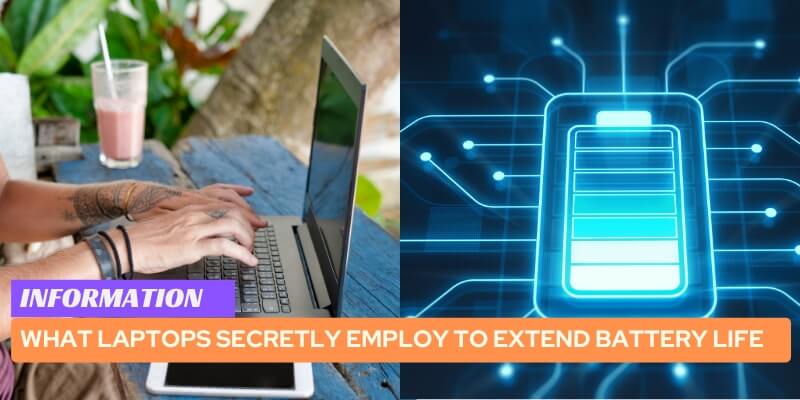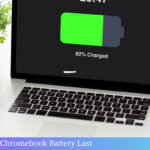Laptops conserve battery power by dimming the screen, reducing processor speed, and enabling power-saving mode. With the growing reliance on portable computing devices, laptop battery life has become a crucial factor for many consumers.
Whether you’re working remotely or want to use your laptop without being confined to a power outlet, conserving battery power is essential.
Laptops are designed to maximize battery life through various techniques. Laptops can significantly extend their battery life by dimming the screen, reducing processor speed, and enabling power-saving mode.
We will explore the different methods that laptops use to conserve battery power and provide you with useful tips to optimize your laptop’s battery life.
So, let’s dive in and discover how you can make the most of your laptop’s battery power.
Table of Contents
- Secrets Behind Battery Optimization
- Efficient Power Management Techniques
- Advanced Battery Optimization Features
- Strategies For Extending Battery Life
- Maximizing Battery Performance
Secrets Behind Battery Optimization
In today’s fast-paced world, where laptops have become an integral part of our lives, maximizing battery life has become a top priority for many users.
The secrets behind battery optimization lie in the intelligent use of power-efficient components, advanced power management systems, smart charging techniques, and hardware and software integration optimization.
Let’s explore each of these factors in detail:
1. Usage Of Power-efficient Components
Laptops that are designed to conserve battery power utilize power-efficient components. These components are carefully selected and crafted to balance performance and power consumption.
Processors like Intel’s low-power variants consume less energy while delivering sufficient computing power for everyday tasks.
Similarly, Solid State Drives (SSDs) are energy-efficient alternatives to traditional hard drives, consuming less power while providing faster data access.
2. Advanced Power Management Systems
Advanced power management systems play a crucial role in optimizing battery usage. These systems intelligently manage power allocation to different components based on usage patterns and demands.
They include features like dynamic frequency scaling, which adjusts the processor’s performance based on the workload.
When tasks require less processing power, the system reduces the clock speed, resulting in lower power consumption.
Additionally, automatic power-saving modes, such as sleep or hibernate, ensure minimal power drain when the laptop is idle.
3. Smart Charging Techniques
To extend battery life, laptops employ smart charging techniques. These techniques involve monitoring the battery’s charging status and adjusting the charging rate accordingly.
For instance, laptops may limit the charging rate when the battery nears full capacity to prevent overcharging, which can degrade battery health.
Some laptops also offer rapid charge technologies that allow quick charging for short durations.
These techniques maximize battery lifespan and provide users with flexibility in managing their device’s power.
4. Optimization Of Hardware And Software Integration
The optimization of hardware and software integration plays a crucial role in battery optimization.
Laptop manufacturers collaborate closely with software developers to create seamless integration between the laptop's hardware and operating system.
By fine-tuning power management algorithms and optimizing driver software, they ensure efficient utilization of system resources.
This integration allows for better power management, minimizing resource wastage, and maximizing battery life.
Laptops adopt various techniques to conserve battery power, including the usage of power-efficient components, advanced power management systems, smart charging techniques, and optimization of hardware and software integration.
By understanding these secrets behind battery optimization, users can make informed decisions when choosing a laptop and follow best practices to extend battery life.
Efficient Power Management Techniques
The efficient power management techniques laptops employ are crucial in extending battery life and ensuring optimal performance.
By utilizing low-power processors and GPUs, laptops are able to strike a balance between power consumption and performance.
Implementing energy-saving display technologies further enhances power management, while effectively managing background tasks and processes helps minimize unnecessary power consumption.
Additionally, laptops are designed to conserve power during standby and idle periods, maximizing battery life. Let’s delve deeper into each of these techniques.
1. Utilizing Low-power Processors And Gpus
One of the key strategies for efficient power management in laptops is using low-power processors and GPUs.
These components are designed to consume less energy while still providing satisfactory performance.
Compared to their high-performance counterparts, low-power processors and GPUs prioritize energy efficiency, balancing power consumption and the user’s computing needs.
This not only helps prolong battery life but also reduces the overall heat generated by the laptop.
2. Implementing Energy-saving Display Technologies
Another crucial aspect of power management in laptops is the implementation of energy-saving display technologies.
Laptops now incorporate technologies such as LED backlighting and power-efficient display panels. LED backlighting consumes less power than traditional fluorescent lighting.
At the same time, power-efficient display panels optimize brightness levels and adjust backlighting based on ambient lighting conditions.
These advancements reduce power consumption and enhance the visual quality of the displays.
3. Managing Background Tasks And Processes Effectively
A laptop’s operating system employs various techniques to efficiently manage background tasks and processes.
These techniques help minimize unnecessary power consumption by ensuring that only essential processes run simultaneously.
By prioritizing tasks and managing resources effectively, laptops can conserve power without compromising on performance.
This technique is particularly important when running resource-intensive applications, as it allows the laptop to allocate power to the necessary tasks while minimizing power consumption elsewhere.
4. Minimizing Power Consumption During Standby And Idle Periods
Another vital aspect of power management in laptops is minimizing power consumption during standby and idle periods.
When a laptop is not actively being used, it is designed to enter low-power modes, such as sleep or hibernation.
These modes help conserve battery life by reducing power to non-essential components while maintaining the necessary functionality to quickly resume tasks when the laptop is awakened.
By intelligently managing power during these periods, laptops can significantly extend battery life, allowing users to work longer without the need for frequent recharging.
Advanced Battery Optimization Features
Regarding laptops, conserving battery power is crucial for prolonging usage and enhancing productivity.
With technological advancement, laptops are equipped with advanced battery optimization features that help maximize battery life and efficiency.
From adaptive brightness and display settings to power-saving modes and profiles, intelligent cooling systems, and battery health optimization, these features ensure that your laptop runs smoothly while minimizing unnecessary drain on its battery.
1. Adaptive Brightness And Display Settings
One of the laptops’ notable battery optimization features is the adaptive brightness and display settings.
These settings automatically adjust the screen’s brightness based on ambient light conditions.
Laptops reduce unnecessary power consumption by dimming the screen in low-light situations and increasing the brightness in well-lit environments.
This extends battery life and provides a comfortable viewing experience without straining your eyes.
2. Power-saving Modes And Profiles
In addition to adaptive brightness, laptops offer power-saving modes and profiles that allow users to customize energy consumption based on their needs.
To minimize power usage, these modes, such as ‘Power Saver’ or ‘Battery Saver,’ optimize various system settings, including CPU performance, screen brightness, and background activities.
By activating these modes, you can ensure that your laptop conserves battery power when you’re on the go or working in situations where charging may not be readily available.
3. Intelligent Cooling Systems For Thermal Management
Laptops are equipped with intelligent cooling systems, which are vital in battery optimization.
These systems efficiently manage the laptop’s temperature, preventing overheating and reducing power consumption.
By regulating fan speeds and adjusting cooling mechanisms, laptops ensure that excessive heat is dissipated effectively, allowing the battery to operate optimally.
Intelligent cooling protects the laptop’s internal components and contributes to extended battery life and overall performance.
4. Battery Health And Lifespan Optimization
While battery optimization features focus on maximizing immediate power efficiency, laptops also offer features that safeguard battery health and lifespan in the long run.
These features include charge limit settings, which prevent the battery from overcharging and reduce wear and tear on its cells.
Additionally, laptops employ intelligent charging algorithms that adjust the charging rate based on the battery’s current state.
By optimizing the charging process, laptops ensure that the battery lasts longer, providing sustained performance over time.
Overall, laptops have advanced battery optimization features designed to conserve power, enhance performance, and increase productivity.
Through adaptive brightness and display settings, power-saving modes and profiles, intelligent cooling systems, and battery health optimization, laptops offer users the ability to make the most of their battery life.
Utilizing these features allows you to enjoy longer usage times and improved efficiency, both at home and on the go.
Strategies For Extending Battery Life
1. Tweaking System Settings For Power Efficiency
One of the most effective strategies for extending your laptop’s battery life is to tweak the system settings to maximize power efficiency.
By adjusting specific settings, you can reduce the amount of power consumed by your device and make your battery last longer.
Here are some key settings to consider:
- Brightness: Lowering your screen’s brightness level can significantly reduce power consumption. You can usually adjust the brightness settings in the Control Panel or System Preferences.
- Display sleep: Setting a shorter display sleep time ensures that your screen turns off quickly when it’s not in use. This can save a considerable amount of battery power.
- Power plan: Choosing a power-saving power plan can optimize your laptop’s energy usage. Look for an option that reduces processor speed and limits background activity.
- Hibernate mode: Enabling hibernate mode will allow your laptop to save the current state of your work and power down completely. This is especially useful when you must idle your laptop for an extended period.
2. Disabling Unnecessary Background Applications And Services
Background applications and services can consume a significant amount of battery power even when you’re not actively using them.
You can conserve energy and prolong your battery life by disabling unnecessary processes.
Here are some steps you can take:
- Task Manager: Open the Task Manager (Ctrl + Shift + Esc) and navigate to the “Processes” tab. Identify any unnecessary applications or processes that are running and consuming resources. Right-click on them and choose “End Task“.
- System Configuration: Open the System Configuration utility by typing “msconfig” in the Run dialog (Win + R). In the “Startup” tab, uncheck the boxes next to any unnecessary startup items. This will prevent them from running in the background.
- Services: Type “services.msc” in the Run dialog (Win + R) to open the Services window. Disable any unnecessary services that are running in the background. Be cautious not to disable essential system services.
3. Managing Wireless Connectivity Options
Wireless connectivity features such as Wi-Fi and Bluetooth can consume a significant amount of battery power.
Turning off these features when not in use can help extend your laptop’s battery life.
Here’s how:
- Wi-Fi: Disable Wi-Fi when you’re not connected to a network or not actively browsing the internet. You can do this by clicking on the network icon in the system tray and selecting the Wi-Fi option.
- Bluetooth: If you’re not using any Bluetooth devices, it’s best to turn off Bluetooth to conserve battery power. You can access the Bluetooth settings in the Control Panel or System Preferences.
4. Utilizing Battery-saving Apps And Software
There are various battery-saving apps and software available that can optimize your laptop’s power usage and help extend its battery life.
These applications monitor and manage background processes, system settings, and power consumption.
Here are some popular options:
- Battery Saver: Battery Saver is a built-in feature in many laptops that automatically adjusts system settings to maximize battery life. You can enable Battery Saver mode in the Power Options settings.
- Battery optimization apps: Install battery optimization apps like BatteryCare, Battery Optimizer, or PowerTOP. These apps provide detailed information about your laptop’s battery health and offer features to optimize power usage.
- Power management software: Some laptop manufacturers provide their own power management software, such as Lenovo Power Manager or Dell Power Manager. These applications offer advanced power-saving options specific to your laptop model.
By implementing these strategies and making some small adjustments to your laptop’s settings, you can greatly extend its battery life.
Remember to practice good battery maintenance, such as avoiding extreme temperatures and regularly calibrating your battery, to ensure optimal performance and longevity.
Maximizing Battery Performance
1. Best Practices For Battery Calibration
Calibrating your laptop battery periodically is essential for maximizing its performance and ensuring accurate power readings.
Follow these best practices for battery calibration:
- Charge your battery to 100%: Start by charging your laptop battery to its maximum capacity. Keep it plugged in until it reaches a full charge.
- Use your laptop on battery power: Unplug the power adapter and use your laptop solely on battery power once your battery is fully charged. Allow the battery to discharge naturally until it reaches a low level.
- Leave it unattended: To complete the calibration process, let your laptop remain unused and powered off for a few hours or overnight. This step ensures that any residual charge is dissipated.
- Recharge the battery: After the discharge period, plug in the power adapter and charge the battery back to 100%. It is crucial not to interrupt the charging process during this stage.
By following these calibration practices at regular intervals, you can improve the accuracy of your laptop’s battery readings and extend its overall longevity.
2. Importance Of Regular Software Updates
Regular software updates are vital in maximizing your laptop’s battery performance.
Here’s why keeping your system up to date is crucial:
- Bug fixes and enhancements: Software updates often include bug fixes and performance enhancements that can optimize your laptop’s power consumption. These updates address any underlying issues that may be draining your battery unnecessarily.
- Security patches: Updates also include essential security patches that protect your laptop from vulnerabilities. A well-secured system reduces the risk of malware or other malicious activities that can drain your battery or compromise your device’s overall operation.
- New power-saving features: Manufacturers continuously work on improving power management technologies. Software updates may introduce new power-saving features, allowing your laptop to conserve battery power more efficiently.
To benefit from these advantages, make it a habit to regularly check for software updates and install them promptly.
This simple practice ensures that your laptop’s operating system remains optimized for battery performance.
3. Optimizing Battery Usage For Specific Tasks
Tailoring your laptop’s battery usage for specific tasks can significantly improve performance.
Consider these tips for optimizing battery usage:
- Adjust screen brightness: Lowering your screen brightness conserves battery power. Reduce it to a comfortable level, especially when working in well-lit environments.
- Close unnecessary applications and processes: Quit any non-essential programs and background processes that consume significant system resources. This practice minimizes battery drain and improves overall performance.
- Enable power-saving modes: Take advantage of the power-saving modes available in your laptop’s settings. These modes adjust various system settings to optimize power consumption based on your usage requirements.
- Manage Wi-Fi and Bluetooth: When not needed, disable Wi-Fi and Bluetooth to prevent your laptop from wasting energy by continuously searching for connections.
- Avoid excessive multitasking: Running multiple resource-intensive tasks simultaneously increases your laptop’s battery strain. Consider completing tasks sequentially to avoid unnecessary battery drain.
By optimizing your laptop’s battery usage for specific tasks, you can make the most of your battery power and extend its overall performance.
4. Smart Tips For Extending Battery Lifespan
Ensuring that your laptop battery lasts as long as possible requires a proactive approach.
Consider these smart tips for extending your laptop’s battery lifespan:
- Avoid extreme temperatures: Exposure to extreme heat or cold can significantly impact your battery’s lifespan. Keep your laptop within a comfortable temperature range to maintain optimal battery health.
- Avoid constant full discharges: Frequently allowing your battery to completely discharge can reduce its lifespan. Instead, aim to keep your battery level between 20-80% for optimal performance.
- Store your laptop properly: If you’re not using your laptop for an extended period, store it in a cool, dry place with a battery level between 40-60%. This helps prevent the battery from losing capacity during storage.
- Unplug when fully charged: Once your laptop battery reaches 100% charge, unplug the power adapter to avoid unnecessary stress on the battery. Overcharging can lead to decreased battery performance over time.
- Limit background processes: Minimize the number of unnecessary background processes running on your laptop. This reduces the strain on your battery and increases its overall lifespan.
By following these smart tips, you can ensure your laptop battery lasts longer, saving you money on replacements and contributing to a more sustainable environment.
Frequently Asked Questions For What Laptops Secretly Employ to Extend Battery Life
What Laptops Conserve Power?
How Do Laptops Conserve Battery Power?
What Are Power-saving Settings On Laptops?
Do Laptops Save Battery By Reducing Screen Brightness?
How Can I Optimize My Laptop’s Power Usage?
Does Using Wi-Fi Drain Laptop Battery?
Are Certain Applications More Battery-intensive Than Others?
Can Adjusting The Power Plan Settings Improve Laptop Battery Life?
Does Using A Screensaver Conserve Laptop Battery?
Can Using External Peripherals Affect Laptop Battery Life?
Conclusion on What Laptops Secretly Employ to Extend Battery Life
Overall, laptops have become increasingly efficient in conserving battery power.
Through the use of advanced technology, such as power management systems and energy-efficient components, laptops are able to extend their battery life significantly.
From optimizing software performance to implementing power-saving strategies, manufacturers are continuously striving to provide users with longer battery life without compromising on performance.
As a result, users can now enjoy the convenience of a portable device that lasts longer and operates efficiently, allowing them to accomplish their tasks without constantly worrying about their battery running out.






